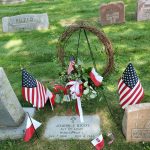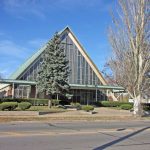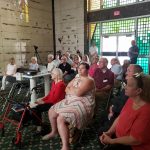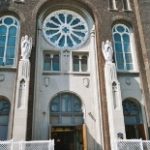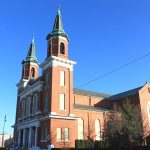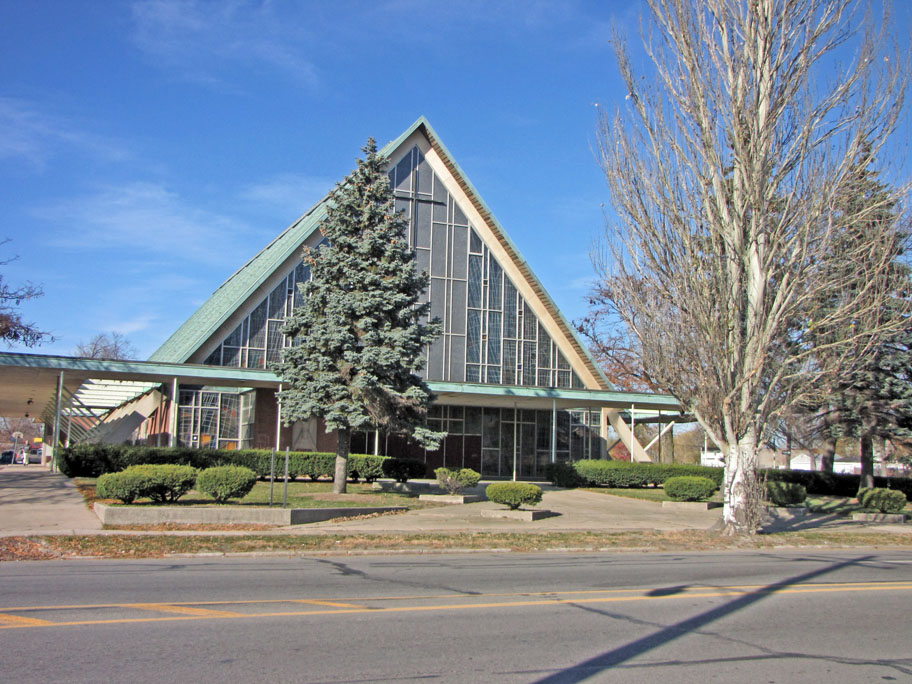
DEMOLITION OF ST. ANDREW CATHOLIC CHURCH
7060 McGRAW, DETROIT 48210
Demolition of historic St. Andrew Catholic Church at 7060 McGraw began at the beginning of June of 2021 and was nearly completed by the end of the month. The church had been used as a chapel since its closing in August of 2008. At the time of the parish’s closing, Masses were still being celebrated in both Polish and English.
Approximately 800 attended the final Mass on August 31, 2008. Bishop Daniel E. Flores was among the Mass celebrants. Rev. Gary Michalik served as Master of Ceremonies. At the end of the Mass, the statue of St. Andrew, the parish’s namesake, was carried out of the church in a sad procession. The West Side Detroit Polish American Historical Society presented a framed memorial to the parishioners and their pastor, Rev. Julian Chmura, the last pastor of St. Andrew.
The parish was founded in November of 1920 by ten residents of the McGraw-Chopin area. The original church was a simple frame structure, 90 feet by 46 feet, with a seating capacity of 550, and it was constructed in 15 and one-half working days. The first pastor was Rev. Maximilian Gannas.
Bishop Michael J. Gallagher, along with ten clergy from neighboring parishes, blessed the newly installed church bell on February 20, 1921.
On May 9, 1923, Rev. Stephen Trepczynski of St. Michael parish in Port Austin succeeded Rev. Gannas, and a new church and school were dedicated on September 14, 1924. The church was growing so rapidly that the school basement was used as a temporary church while construction of the rectory began. The new school was blessed by Bishop Gallagher on September 19, 1926, with the assistance of 25 priests and in the presence of a crowd of approximately 5,000.
There were plans in 1945 to build a Romanesque-style church with a seating capacity of 1,000 at a cost of approximately $250,000. N. Kostrzanowski was proposed as the architect. Rev. Trepczynski indicated that $220,000 had already been secured for the church’s construction. Although Archbishop Mooney approved the plan, it never came to fruition.
In 1949, an activities building was built, and in 1951, new pews were installed at a cost of $14,000. After Rev. Trepczynski resigned in 1954 due to poor health, Rev. Francis A. Banaszak became pastor. Later, $12,400 was invested in remodeling the gymnasium.
The final, permanent church structure was built in 1956, following which the former basement church was converted into ten classrooms. The upswept pitch of the church’s roof “forms its own spire, lifting the eye upward to create an atmosphere of worship.”
The parish school closed in June of 1987. The Felician Sisters, who taught at the school, had a great influence on the students, and there were 15 Felician principals at the school throughout the years.
Since the church’s closure in 2008, the buildings have been used largely by community organizations. A West Bloomfield Township-based foundation purchased the church building, rectory, and garage in November of 2020. However, due to environmental and safety issues, the church could not be saved.
As of June of 2021, Starfish Family Services owns the gymnasium, school building and convent. The Detroit Police Athletic League still hosts youth events in the gymnasium. The vacant land left by the demolition will be used as a community green space, and the foundation plans to relocate its headquarters to the site.
On June 1, 2021, Rev. Gary Michalik, the Society’s president, procured the church’s cornerstone contents for the Society’s archives. Upon arrival at the demolition site on that day, Fr. Gary found that 90 percent of the church already had been demolished. The façade facing McGraw was the only portion remaining. He learned that the cement was crumbling around the steel I-beams at ground level, and due to its unsafe state, as well as the amount of asbestos within the structure, it was not possible to save it.
Fr. Gary observed a huge crane grabbing parts of the building and pulling it down. He saw the black marble cornerstone on the ground. He approached the crane operator and asked if he could have the cornerstone. He hoped it helped that he was wearing his Roman collar and that he produced his business card.
The work crew obtained permission from their manager to give the cornerstone to Fr. Gary. However, they said that it weighed 300 to 500 pounds and that there was no guarantee that it would not damage Father’s vehicle. Fr. Gary decided not to risk damaging his vehicle, but when he saw the contents of the cornerstone through an oval opening, he decided to try and procure them. It is customary to place items of significance—such as the original blueprints and religious icons—inside a church’s cornerstone at the time that it is laid. He asked for and was granted permission to have the cornerstone’s contents.
The oblong metal box that was pulled from inside the cornerstone appeared to have been custom made for it. It had been soldered shut. The work crew hand-sawed the box open, and it seemed to Fr. Gary that the laborers greatly anticipated that they would find a huge amount of money inside the mysterious box. Instead, there was a small crucifix with the corpus detached, several corroded religious medals, a six-inch ruler from Orchard Lake St. Mary’s, a Cylkowski Funeral Home business card, a newspaper article from the 1950s, and a devotional book to the Blessed Mother—all of which were severely water damaged. It was a mystery how the items got damaged by water since the box had been soldered closed.
The Society board members will attempt to have the corroded medals cleaned and repaired. The crucifix has been cleaned and repaired. While not a million dollars, the items are great treasures from a historical perspective and have been accepted into the Society’s archives.
Honorary Society Member Steve Isaacson retrieved a brick from the church, which also has been accepted into the Society’s archives.
Sources:
- Benavides-Colón, Amelia. “Neighborhood bids farewell to iconic Detroit church.” In the Detroit News. June 26, 2021.
- “Golden Jubilee – St. Andrew’s Parish – Detroit, Michigan – 1920 – 1970” (WSDPAHS archives)
- Isaacson, Steve. Informal discussion. Livonia, MI: June 24, 2021.
- Michalik, Rev. Gary. Report to the West Side Detroit Polish American Historical Society Board of Directors. Livonia, MI: August 17, 2021.
- Photo of St. Andrew Church Exterior by Laurie A. Gomulka: November 28, 2010.
